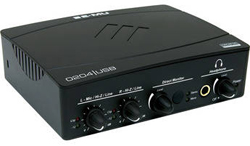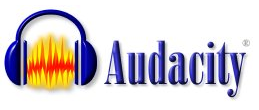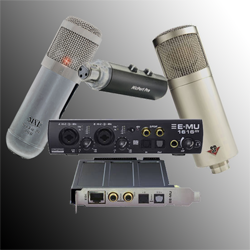So it turns out not everyone can afford expensive software for recording. Maybe they had one decent microphone, maybe a USB mic to plug into their totally regular computer, but no more money left over to go to a recording studio or to purchase expensive software (not to mention expensive hardware) to record and then create something really awesome. Is it possible to still come up with something professional sounding using only free recording software and plug-ins?
If you are asking me, the answer is “yes.” But there are some qualifiers. As with many things, it is going to take you longer to get good results than it would if you were able to afford the paid versions of software and plugins. It’s the whole trading time for money thing and vice versa. Also, if you have some basic knowledge of audio recording, you will be more likely to achieve good results. Luckily that knowledge not terribly difficult (at least it doesn’t HAVE to be) and is something you can get from tutorials like our Newbies Guide to Audio Recording Awesomeness , but I digress.
Here is an article that shares my view that it is possible to get a great sounding mix with cheap/free software.
http://www.audiorecording.me/can-you-achieve-quality-audio-mix-using-only-free-plugins.html
good recordings on a budget
2 Things You Should Know About Your PC Recording Studio
 What? You say you don’t have a PC recording studio? Let me ask you this. Do you have a computer? Was it made in the last 10 years? Does it have a sound card? If you answered “yes” to all 3 questions, you have a PC recording studio. Maybe you just didn’t know it.
What? You say you don’t have a PC recording studio? Let me ask you this. Do you have a computer? Was it made in the last 10 years? Does it have a sound card? If you answered “yes” to all 3 questions, you have a PC recording studio. Maybe you just didn’t know it.
So now that you DO know, you can create awesome audio for, well, for whatever. Record your songs and release an album. Send out a podcast. Narrate an audio book. Do voiceover recording for any videos you might be making, or to start a voiceover business of your own. There are so many possibilities.
Now before anyone raises their hand to protest that you can’t record really good audio using just a home computer unless you also spend a gazillion dollars on an audio interface, microphones, and special software, let me just say something first. You CAN record really good audio using just a home computer without having to spend a gazillion dollars on an audio interface, microphones, and special software. In fact, getting back to the title of this article, there are two important things about home recording you should know. First, good audio is more about knowledge than money, knowledge anyone can learn quite easily given the right lessons. Second, most people can create excellent sounding audio without spending more than about 30 dollars (for a USB mic if you don’t already have one).
1. The Basics of Home Recording are Easy to Learn
Most home recording needs will center around voiceover recording for any of a number of reasons, such as podcasts, audio for video, audio books, etc. You will probably have noticed that a lot of amateur narrated audio such as you find in videos on YouTube is really quite bad. It’s thin, echo-y, noisy, hard-to-understand, or any combination of the above. But that isn’t because the people recording this audio just have cheap gear. They could make much better audio with just a little knowledge, mainly about how to avoid and/or reduce noise, where to put the mic, etc.
2. You Can Create Good Audio With Your Current Computer and Free Recording Software
There are some good audio recording programs available free of charge on the web. Probably the best known is called Audacity. When I say “free,” I mean open source, not just a trial version. Audacity is amazingly powerful for the price ($0.00). I recommend you download it before someone figures out how good a deal it really is. Audacity is both a multi-track recording and sound editing software. It comes with lots of built-in effects like EQ, compression, reverb, and great editing capability. For many folks, especially the ones just recording vocal narration, this is the only home recording software they’ll ever need.
So now you know where to get the hardware, but you are wondering where you can gain the knowledge I said was so easy to understand. There are many tutorials on the web, but Home Brew Audio is dedicated to teaching home recording skills so that anyone can understand them, using enjoyable and humorous video tutorial videos. Why not give us a visit at www.homebrewaudio.com if you have a few moments? I bet you’ll be glad you did.
What is An AD Converter?

What is an AD converter? Well, “AD” means “analog-to-digital.”So an AD Converter is basically a translator for audio. It takes audio from one end and changes it to something a computer can understand, spitting that out the other end.
The result of analog-to-digital conversion is actually more common than you might realize. Analog-to-digital converters go by quite a few names, including A-D converters, ADC, and A/D converters.
The reverse is also available, being a D-A converter, or DAC. D-A converters might be part of an interface box, such as with the EMU 0404 in the picture on the left) or a separate component.
I’ll discuss their function shortly. As we’ve discussed recently (see the post 16-Bit Audio Recording – What The Heck Does It Mean?), analog is the physical, continuous signal that our bodies can make and understand (hear). Digital signals are the only thing computers can understand, so converting between the two signals is necessary for any modern recording project.
So What Is It?
There is no way for a computer to store an analog signal without it being first converted to a digital signal. Even though you may not have anything that you know as an ADC, it may be an internal component to other items. Even a cheap $5 PC mic has an ADC inside of it! Different qualities of converters make the conversion in different resolutions. The resolution of a converter is the same as the bit depth of the recording it produces.
Think of this “resolution” as the vocabulary that the converter can use to describe the analog information to the computer. An 8 bit recording only knows 256 words, while a 16 bit recording knows 65,536 words.
If that seems like a great improvement, how about 24 bit recordings which use over 16 million words? There’s not actually some robot inside each ADC writing wordy reviews of your recordings for the computer, but the reality isn’t too far off. With higher bit depth and resolution, the digital recording will be much cleaner. You might not notice a huge difference between 16 and 24 bit recordings, but you will certainly be able to hear the difference between 8 and 16 bit.
Some A-D converters will also make the reverse conversion via the audio-out plug. Remember that humans can only understand analog signals, so it’s necessary to convert from the digital information on the computer and turn it into an analog signal for the speakers to turn into audible sound.
How Do I Convert My Audio?

The internal A-D converter that comes with some products is usually of moderate quality. The quality of your recordings will not be higher than your lowest quality piece of equipment, so an upgrade to a separate interface box will eventually be necessary.
There are plenty of options on different converters, so getting the right one for your home recording needs might not be as simple as it sounds. You might be surprised at how many different options there are.
You can start to get decent converters in audio interface boxes starting around $100 these days (not so only as recently as 5 years ago), but as with most things used in recording there are also cheaper versions and much more expensive versions available. The EMU 0404 (which is an interface that happens to contain excellent AD converters) I mentioned at the beginning of the article runs about $130. Something like the M-Audio/Avid Fast Track also has decent converters inside but only runs about $110 dollars.
Then at the very high end you have dedicated A-D/D-A converters like the Apogee Ensemble 8-Channel Converter, which you can have for a mere $1,729.
So go convert some sound into ones and zeros and make some awesome audio.
Cheers!
Audacity – The Free Audio Recording Software
 Audacity is a bit of a breakthrough in audio software for several reasons. The first of those reasons is that it is free. The second reason is also that it is free. Ok, seriously this time. The third reason is that this software is capable of doing some pretty sophisticated things, especially for the price, which I believe I mentioned once or twice.
Audacity is a bit of a breakthrough in audio software for several reasons. The first of those reasons is that it is free. The second reason is also that it is free. Ok, seriously this time. The third reason is that this software is capable of doing some pretty sophisticated things, especially for the price, which I believe I mentioned once or twice.
So you probably want to know all about it now right? Well I can certainly give you a summary of Audacity, along with the pros and cons. Let’s dive in.
The Good
Like I said, Audacity is pretty amazing for the price. Depending on what kind of recording you are (or plan on) doing, you can get professional level results with this software. In a nutshell, Audacity is an audio recorder and editor that you can use on multiple platforms, including Windows, Mac and GNU/Linux. It is a 32-bit application.
For recording, it is great for capturing one thing, on one track, at a time. This is good news for most folks doing home recording, especially podcasters and other voice over type folks. Just connect a microphone into your computer and hit the big, fat red “record” button and start talking (or singing, or playing an instrument, or… you get the idea). When you’re done, hit the big “Stop” button and you’re done.
If that was all you needed to record (just the one track), and you’re happy with the way it sounds, all you need to do now is “export” it, which saves your audio as a wav file. You can also choose to save your audio as an Ogg Vorbis file, which is a data-compressed file comparable to mp3, which means it takes up less space for internet use, etc. It is also open-source and un-patented, unlike mp3. You can also export your audio as an mp3, but you have to install the the Lame Encoder first. Instructions for doing that are on the Audacity web site. It’s pretty easy.
If you aren’t happy with the audio you just recorded on the one track, you can use any of the dozens of editing tools that are built right in, such as noise reduction, EQ, compression, fading, etc. You can also add effects from the built-in selection, such as echo, delay, phaser, reverser, or play with the time and pitch tools. Those are just to name a few. The latest version of Audacity (1.2.6 or the beta version 1.3.14 as of December 2011) can utilize VST plugins as well. This means you can add effects and editing tools from 3rd party programs as plugins. With 1.2.6 you need to install something called the VST Enabler in order to use VST plugins. The beta version has support for VST built in.
If you want to add tracks to play along with your first track, you can also do that while listening to the first one play back. This, in effect, turns Audacity into a multi-track recorder as well. You can use this function to add background music behind your voice. Or you can even sing harmony with yourself (or whoever), record other instruments to make yourself a one-person band, etc. When you’re done adding these additional tracks, just mix the volumes together and maybe pan the tracks so that some of the sounds sound like they’re coming from the left, some from the right, and some from the middle, and then export your production.
The Maybe Not-So-Good
I finished up the “The Good” section talking about using Audacity for multi-track recording. One thing that is a problem when doing this is that there are synchronization issues between the tracks. I find I have to manually slide the audio on a track left or right to get it to sync up with the audio in the track above it, which is a bit wonky.
Another huge drawback (though remember, we ARE talking about free and very basic software here) is that you can’t do anything with MIDI or virtual instruments. So for musicians, this is probably not the best software to use if you want to produce professional music tracks.
The quality of the built-in effects is also not the highest. The noise-reduction tool is one example of this. I found that it was very difficult to do much noise reduction without the resulting audio having the tell-tale “under-water” sound to it. Compared to the audio restoration tools in programs like Adobe Audition, it is definitely not great.
Another thing that I find to be a problem with Audacity is that it just tends to be very complex. I’ve heard folks say that you need to have an engineering degree to figure it out. I don’t know if that’s true. There are certainly lots of tutorials out there. Heck, the entire first module of our home recording course – The Newbies Guide to Audio Recording Awesomeness 1 uses Audacity exclusively, mainly because we wanted to start folks out with a budget of $5.00 or less. But without some good guidance like that, I’d have to say the Audacity is not very user-friendly, especially to folks who are just beginners in the audio recording world.
There you have your down-and-dirty overview of Audacity, the free audio recording software that can do some amazing things, especially for the price.
Cheers!
Ken
Home Studio Microphone and Interface Questions Answered
 I received an e-mail this weekend asking for feedback on a few questions regarding a few specific home studio microphones and interfaces. Below is the text of the e-mail followed by my answer back to the individual who asked.
I received an e-mail this weekend asking for feedback on a few questions regarding a few specific home studio microphones and interfaces. Below is the text of the e-mail followed by my answer back to the individual who asked.
Question: Hey Ken, I have a question I thought only you could yield a pro and honest answer to. What wold you recommend between the MXL VO: 1-A from the Harlan Hogan sig. series and the Studio Projects C1?
For the audio interface, Centrance MicPort Pro, Firewire Solo, or EMU 0204? Any light shed on this subject would help a lot.
I am getting too much underlying hissing noise in my Samson C01U USB mic. I need to upgrade to a different set-up that is of higher quality, but not break the bank.
Your opinion is appreciated.
Thank You,
Brian
Answer: Hi Brian. Here are my 2-pence.
Between the MXL VO 1a from HH and the Studio Projects C1, I’d recommend going with the C1. I base this on 2 things. First, there have been some questions about the quality control with the MXL. It’s a good mic but the factory seems to be inconsistent in that some mics a really good and others are less so. That’s a concern. (see the review on this here). Secondly, Recording Magazine has been giving outstanding reviews to Studio Projects mics for the past couple of years.
On the interface question, a lot depends on your budget.
- The EMU is so much better than the other two options as to be a no-brainer if you can afford the $449 for it. Its quality is top-notch and you get a nice number of inputs (16).
- The Firewire Solo is not a good choice because it relies on old (firewire) technology and has been discontinued by most retailers.
- The Centrance MicPort Pro is a different animal altogether. Because it is not an interface “box”, but rather a small tube that will fit in your pocket (though that may not be recommended:)), it provides great flexibility and portability. And it costs a lot less than the EMU.
To answer your question about the C01U – The internal converter only allows for 16-bit recording, which will result in a higher noise floor (more hiss) than 24-bit conversion. The guts of this particular mic allow you to reduce that hiss if you increase the level of the signal to “as loud as possible.” For example, if you are recording vocals make sure to be quite close to the mic and record at as high a level as possible without distorting and that will help. However, if you really would like to avoid the hiss in the first place, you’ll need to try a converter that can record at 24 bits. Either of the interface options you asked about above will give you this if you use a non-usb mic, like either of the mics you asked about above. If you would like to continue going the USB mic route, check out the MXL Studio 24, which should give you considerably less hiss. That one costs $149.99.
So here are the options in front of you to really upgrade from just using the C01U going directly into your computer:
- Upgrade to the MXL Studio 24 for less noise: $149.99
- Get a Studio Projects C1 along with a Centrance MicPort Pro: $399.94
- Get a Studio Projects C1 along with an EMU 1616M: $698.95
I hope that helps!
Cheers!
Ken